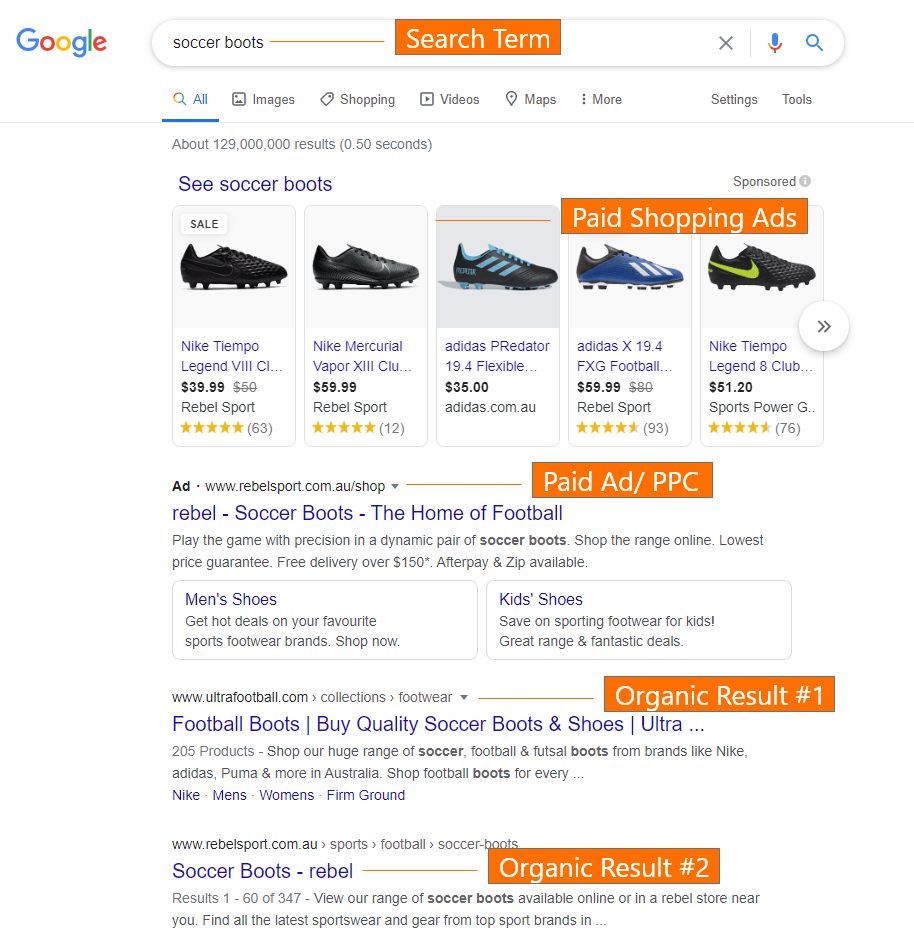SEO Copywriting Tips
As technical as it sounds, copywriting for SEO purposes isn’t as hard as you may think. But before we launch into it, let’s cover a few simple basics first - think of it as a refresher crash course.
What is SEO?
SEO stands for Search Engine Optimisation. Now there’s lots of ways you can approach SEO, but in this blog I’ll focus on the copywriting aspect.
Whenever you type something into Google, or any search engine, the words and phrases you’re typing in can be referred to as ‘keywords’ and ‘search terms’.
For example, if you’re looking for a pair of shoes to wear when you play soccer, you might search “soccer boots”. That’s a short-tail keyword and is because it’s rather generic, it’s also more competitive.
On the other hand, its long-tail variety would be “buy soccer boots online melbourne”. That’s a specific search phrase and indicates that the user knows exactly what they’re looking for - they want to purchase a pair of soccer boots online, with delivery to or within Melbourne. This also means that they’re a hot lead and have a higher likelihood of converting if your website caters to their need.
Examples of SEO keywords in action
To make it super simple, here’s what you need to do:
Research and compile the keywords that your customers might use. Not sure? Look at what keywords your competitors are using.
Narrow down that keyword list and keep all the ones that are relevant to your business. You can group similar keywords together.
Create website content that targets the keywords. As a general rule, each page should target a specific set of similar keywords.
I’ll cover SEO copywriting in more detail down below.
Tip: If you’re just starting out, make sure that you are focussing on targeting long-tail keywords! They might have less search traffic, but their specificity can make the click-through worthwhile.
What is copywriting?
Copywriting is a form of writing and re-arranging words for sales and marketing, with the intention of getting the reader to take action. It’s a form of salesmanship through the written word.
So you might do copywriting for things like a brochure, website or email - the end goal is to get sales or conversions.
What’s the difference between copywriting and content writing?
On the other hand, content writing is used primary to inform, educate or entertain. Examples in action might be writing content for a blog or a buying guide. As a business owner, you should be complementing your salesy aspects with quality content - they go hand-in-hand.
Crafting useful content that empowers your customers can help to set you apart by giving you a voice of authority and establishing leadership within your industry. It’s also a way for you to connect with your audience on a deeper level and allow them to get to know what your brand represents, in a personable way.
Okay, so what’s SEO copywriting?
According to Neil Patel, “SEO copywriting is all about creating useful, compelling and valuable content that targets specific keywords so that other people will gladly promote it on social media platforms.”
Basically, SEO copywriting is a content optimisation method that helps your website rank higher than other websites for specific search terms. To maximise FREE traffic to your website, you’ll want it to rank higher within the organic results.
Based on the selected keywords you write for, you can effectively target your customers and provide them with relevant solutions through well-crafted SEO copywriting.
SEO copywriting checklist - 4 basic tips to get you started
Let’s go back to the soccer boots example. Say you’ve done your keyword research and you’re ready to start writing copy for your website.
1) Segment your keywords and allocate their target pages.
You’ll have one page that targets “soccer boots” and its variants such as “soccer boots online”. On another page, you’ll target “soccer shin pads” and “soccer shin guards”.
You want to make sure that when a user searches “soccer boots” and clicks on your soccer boots page, all they see is soccer boots - this means your page is relevant to their search term and creates a positive user experience. You don’t want them clicking through and seeing a whole jumble of products from mouth guards to shin guards and soccer socks on the one page.
👀 Photographers: I’ve dedicated an entire blog to the importance of creating individual pages for each photography service you offer. The blog also covers the key information you should include on each service page.
2) Optimise each page with your target keywords
There’s a few key areas of opportunity where you can target your list of short-tail and long-tail keywords.
Page title & meta description - this is what customers see on the search results page. Keep in mind that you’ll need to keep to a character limit to prevent your copy from being cut off. I like to use the SEOmofo snippet tool that automatically counts it for you.
Heading tags - you’ll want to have one <h1> tag, a couple of <h2> sub-headings and a few <h3> sub-headings. Use your <h1> heading to make a snappy introduction to your page. Use the <h2> and <h3> headings to target the long-tail keywords.
Examples of page title and metadescription
Examples of SEO headings
3) Internal links to related pages
Internal links are links on one page that go to another page on the same domain. Why are they important?
Internal links help:
Your customers to navigate and explore your website
Establish an information hierarchy and network - think of a pyramid
Spreads link juice and ranking power around your website
Example of internal linking hierarchy from Yoast
Where relevant, you’ll want to help your customer along their journey by encouraging them to explore your site further for related products. So if your main product is soccer boots, you’ll want to have an internal link on your homepage that clicks through to your soccer boots page.
I’ll make some homepage copy up to give you an idea. Say you’ve written this for your homepage:
Take your soccer game to the next level with all the latest gear from Soccer Pros. With fast delivery Australia-wide, we offer the best range of soccer boots and accessories that will see you kicking goals and looking fresh every time you’re on the green.
Where ‘soccer boots’ is in bold and underlined, that’s an opportunity for you to link to your soccer boots page. By doing so, you’re telling your customers and Google that page is the most relevant for the keyword ‘soccer boots’.
4) Target popular questions and longer-tail keywords through helpful content
Remember how I explained why copywriting and content writing goes hand-in-hand earlier in this article? Through blogs, buying guides and resources, you can also employ techniques to complement your overarching SEO strategy.
You could kill two birds with one stone by writing a blog that targets ‘People also ask’ phrases and FAQs as well as your other long-tail keywords.
Use ‘People also ask’ for SEO FAQ ideas
Blog writing allows you to explore trending or popular topics in more detail and is also an opportunity for you to establish trust and rapport with your customers.
Similarly, rather than just flogging them your products, by creating a buying guide you can also empower your customers with useful product and how-to information to help them choose a product that best meets their needs.
👀 Pssst…Are you a wedding photographer? Read this: 9 Easy Blogging Tips for Photographers
And there you have it, all the basic tips to SEO Copywriting
I hope that all of this wasn’t just a massive information overload and that you find it helpful if you’re just getting started with SEO copywriting. As always, I’d love to know what you think about these tips and whether you have any secrets about SEO copywriting that you’d care to share - drop a comment down below.
If you’re a business owner reading this and it’s all a bit overwhelming, that’s what I’m here for. Not the overwhelming bit, but to help you take the load of SEO copywriting off your hands so you can focus on running your actual business. To get the ball rolling, learn more about my website SEO copywriting services or feel free to get in touch with me.
Till the next blog instalment, I’m out!
Chat soon x





